Do job hunting remotely together!
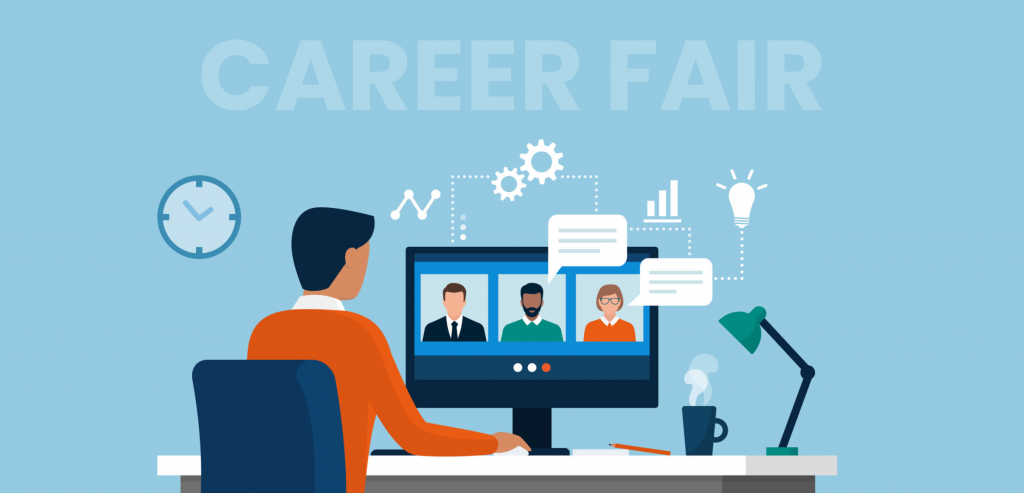
Virtual reality is a hot topic in recent years. Instead of vague concepts, we hope to build a solution that is actually used by and brings benefits to people, and holds them together remotely.
Starting with interviews
There are way too many things that we can work on in doing a social VR. That’s why we did needfindings from gathering opinions through interviews with people around us.
It’s a semi-structured interview with 20 participants, and here’s what we see:
- 3/4 of the respondents have used social VR services before
- What they see are mostly (65.2%) gaming social VR, but there’re also some workplace social VR services that appeared in their sight (occupying 13.0%)
- A majority of users hope that a social VR can bring entertainment, and convenience in workplaces, such as job hunting, each with 21.1% of support; others also are expecting to see VR for education, gathering, outing and religious events
- Almost all these ideas are acting as an alternative to existing solutions – there’re plenty of them, but of course with their own limitation
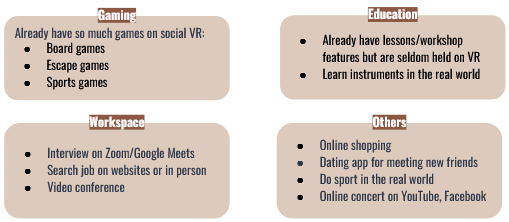
Building a proposed solution
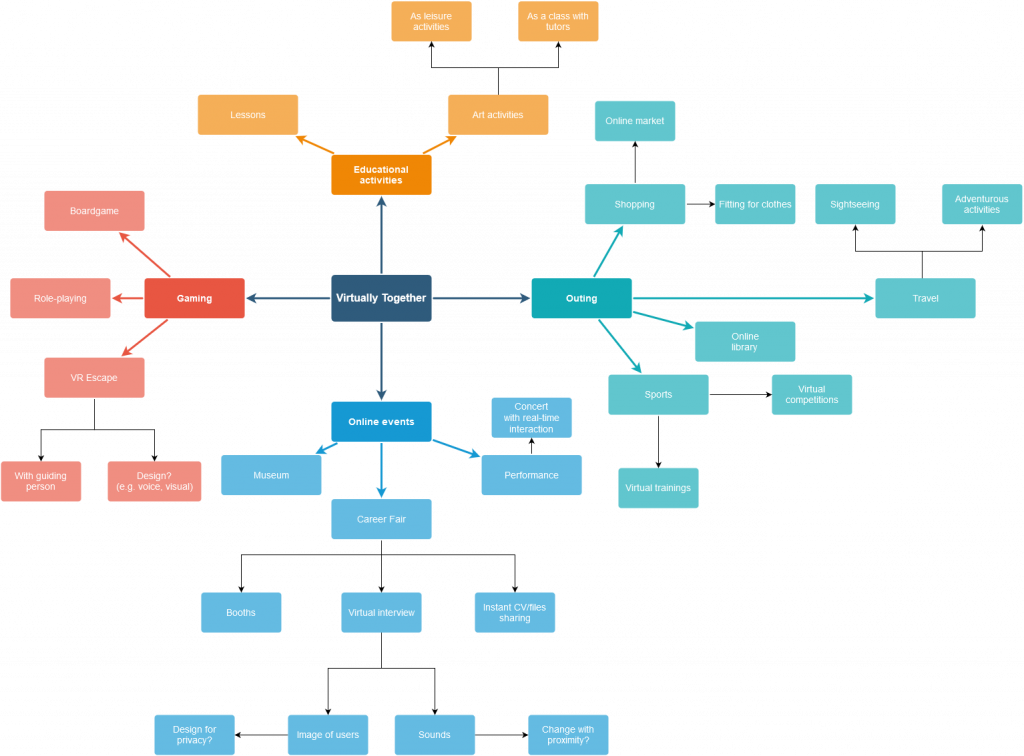
The above mindmap is a summary of all the ideas that we have considered. Just following the result of discussions in the interviews, we looked into the feasibility and values on working on each of them:
- Gaming: There’s already many existing alternatives, and can our prototypes holds higher quality than them (for example, VR room escape game)? (Probably not!)
- Educational activities: Seemly the need is limited as there are already many real-time communications solutions used in education (e.g. Zoom)
- Outing: Eventually, VR cannot replace the experience in many of these activities, such as traveling – it’s still difficult to “feel” the place
- Events: Seemly it’s a more meaningful and feasible solution – we finally decided to focus on virtual career fair due to its popularity and the characteristics that make VR helpful – for example, no need to set up an environment good for video interviews while still being able to do real-time voice chat!
Now that we have settled with the direction we are working on, we need to think of this: job hunting is probably something that most university students have experienced. How can we make the “chemistry” of a career fair happen online?
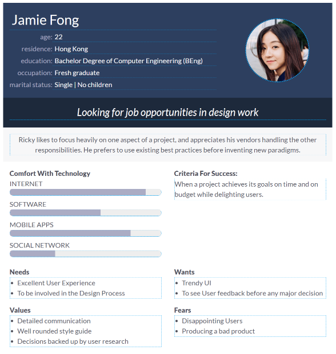
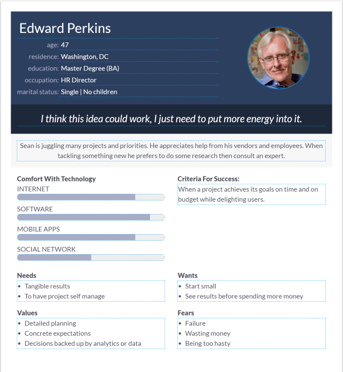
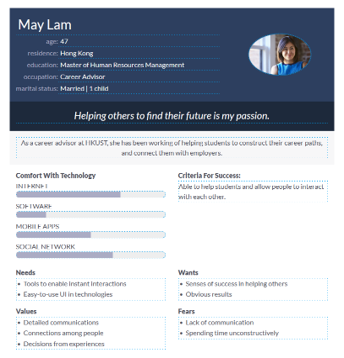
We set up 3 personas for job seekers, employers, and universities respectively. As we analyze, we generated 3 POVs that reflect their needs in a virtual career fair:
- Job seekers want chances to find good career opportunities all around the world
- Employers and Job seekers hope to reduce the time spent to find a match
- Universities want to build connections between employers and students in various ways
What should appear on that platform?
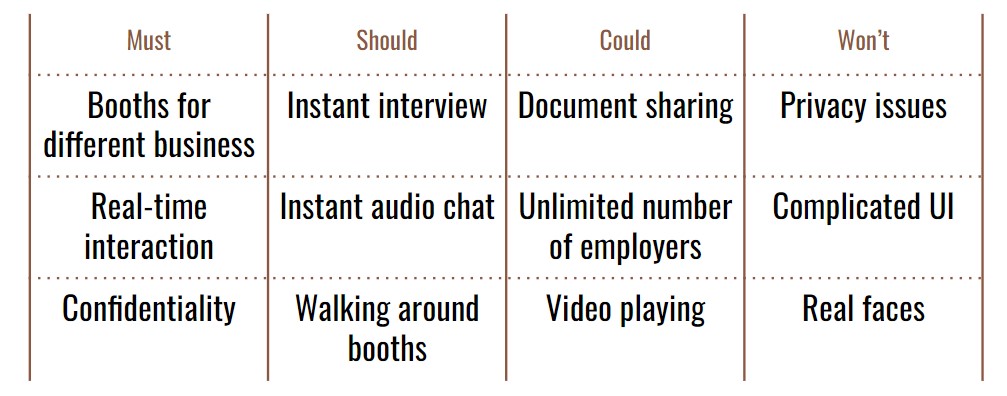
The next step we took is to confirm what features should be included in our prototype. An approach we used is to construct a MOSCOW table, identifying the “must have”, “should have”, “can have”, and “won’t have” in it. Many of those “must have”, “should have” and “can have” are essentially interactive features for the communications between participants and employers, such as instant voice chat and document sharing. It also includes realistic concerns such as privacy issues.
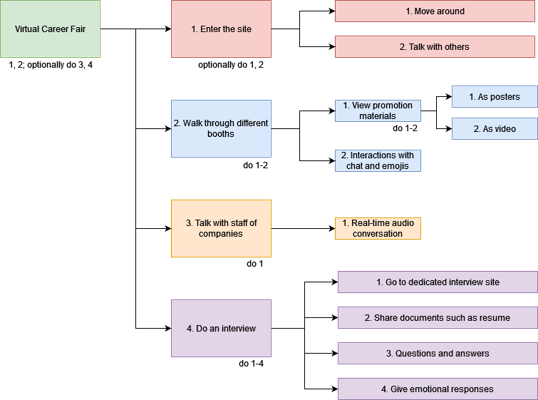
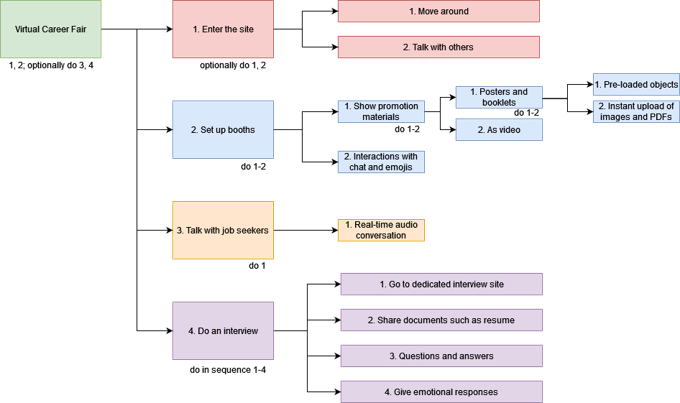
HTAs are also developed so that we can review the flow of operations from different perspectives, namely for job seekers and employers. Here, we explored how can we place different functions in implementations for a satisfying user experience.
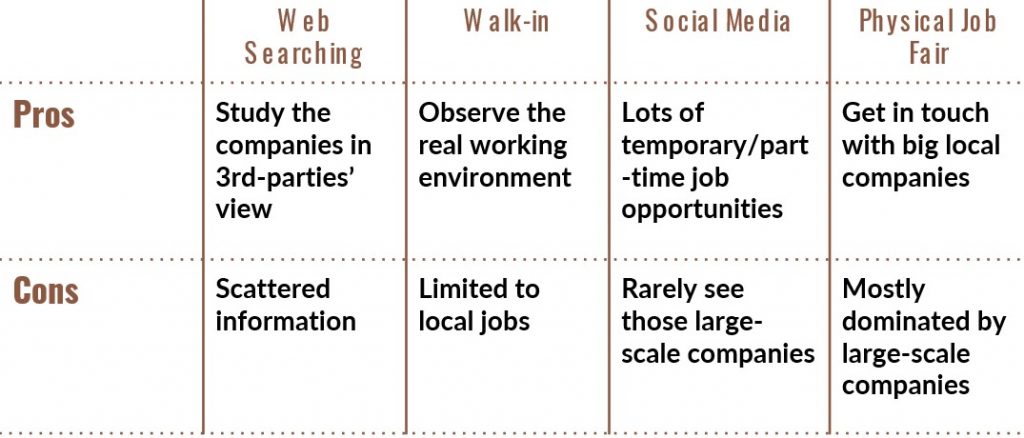
Meanwhile, existing solutions both physically and virtually were reviewed – while they are all having their advantages for us to learn, they also reminded us of issues that we need to notice in developing the solutions, such as offering more organized information and removing geographical barriers.
These all resulted in our final idea, as shown in the storyboard below:
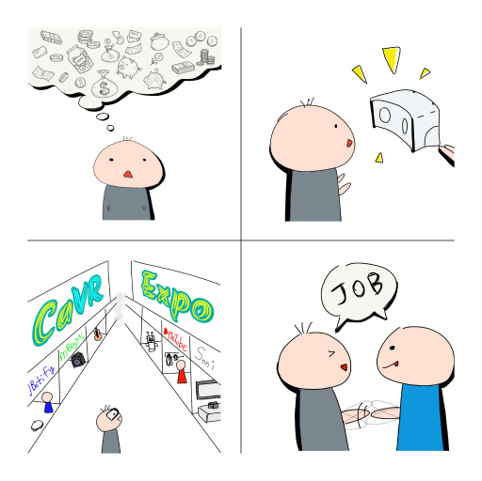
Taking this storyboard, we have done a round of speed dating with potential users again for their further suggestions. Some details for improvements were suggested by them, such as organizing employers’ booths, and fine-tuning interactive features (e.g. allowing adjustment of the volume for audio, sharing of things other than video and image).
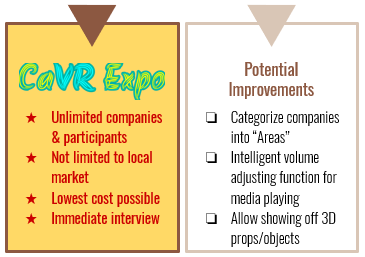
Building the VR!
The above is the final prototype built by our team.
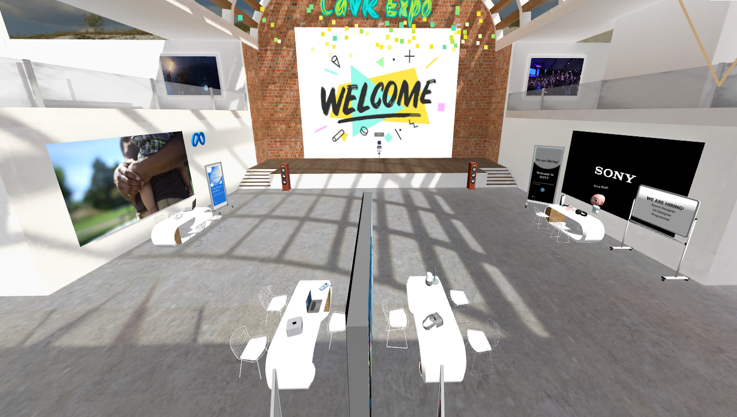
Based on Mozilla Hubs, multiple features that mimic real-life interactions was implemented, like…
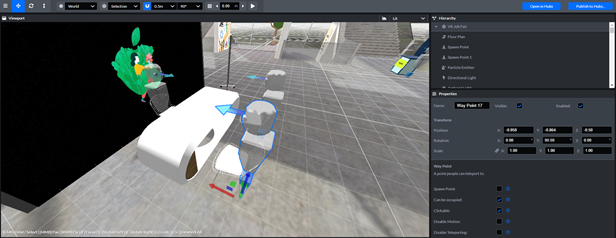
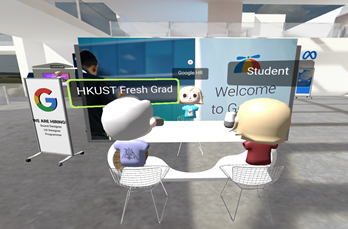
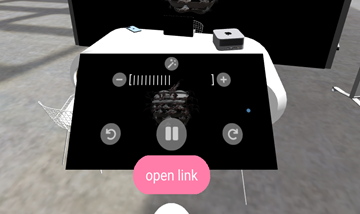

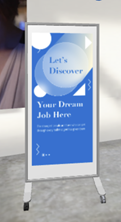
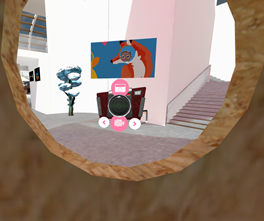
These elements are building blocks for a complete experience in a career expo; while it allows feasibility for employers to set up, e.g. offering a space dedicated for interviews to prevent privacy issues, and showing posters, videos, or even objects in introducing their organizations to job seekers.
Here’s our demo video (and yes, I am that “Sony Staff”):
Feedback
We took this final prototype to another round of user evaluation with both job seekers and employers. Here’s a summary of the results:
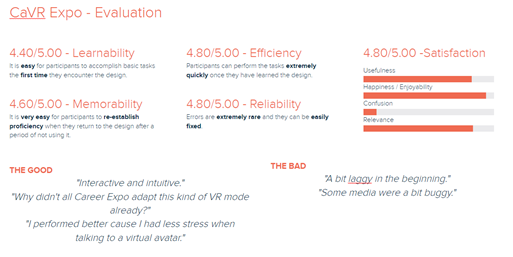
We have received some great feedback stating that the prototype is highly interactive and reduces the stress of job seekers while saving time. There are just minor technical issues such as possible bugs in showing media, but generally, it’s highly welcomed for both job seekers and employers – which is great to hear!
My reflection
Finally, here’s come the last project of this course. It’s on yet another topic that we’re actually experiencing in the pandemic; from the time I was finding an internship back then, to the graduate job seeking which I’m working on now, I have never taken part in a “proper” career fair with any interaction between job seekers like me and employers other than those dry, cold, short text messages. That’s why I am really interested in the topic of building a virtual career expo platform – there’s lots of interaction and therefore exciting, making people like me feel like we’re actually, seriously building our career pathways! While I am trying to walk around the prototype I can feel the power of social VR – I can explore everywhere on the site, having conversations with my teammates, and it feels like what a social event or a career expo should look like for me while being much more relaxing. It’s just like real life, and that feeling was stunning to me!
I am mainly responsible for the ideation process of the project this time, such as organizing ideas from different needfinding participants and teammates to construct a complete ideation mindmap, and building persons and HTAs for detailed user needs and flow in actual operation. Compared to implementation, this is for me a whole new experience – playing a role of confirming and organizing ideations results in a team means that I need to listen to and take extra care of ideas from all the stakeholders and purpose a direction to continue our work, including implementations. This brings me a sense of responsibility – I don’t want to guide my team in the wrong direction in which my teammates would be busy building something not expected by users, while the real needs were ignored!
Such processes taught me to appreciate the effort of everyone and their suggestions on a project – while it’s trivial that implementations take time and can be challenging, other tasks like finding and organizing needs are not easier nor less important. Collecting just random thoughts and making them organized charts and figures were demanding, but fun and satisfying (out of my expectations!)
I always think that communicating with people and knowing how did the solution help is the enjoyable part of product building, and such experience is what I try to look for as I am building my own career path, being a student about to graduate. Not only that makes me enjoy very much “playing” with the prototype we built – as it is just designed for interactions just like real-life, which is treasurable during the pandemic – but also working on the project itself.
Coordination among team members is the key to making that part possible – in reality, we just can’t expect that all those needed collections, designing, and implementations can be done by one single person. Without communication, I would have no way to know how’s the final product like, or are users enjoying it – and the same for all the others in the project! To be honest, when doing projects with implementation involved, I feel frustrated building something while not knowing if users are satisfied!
So, a big thank you to all my teammates – Ada, Gary, Callum, Jay, and Ryan. You are all important to making my journey in exploring HCI so enjoyable, and I am really lucky to be able to stay in such a highly coordinated and friendly team! 🙂